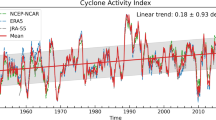Abstract
The objective of this study is to provide evidence of predictability on intraseasonal time scales (10–30 days) for western North Pacific tropical cyclone formation and subsequent tracks using the 51-member ECMWF 32-day forecasts made once a week from 5 June through 25 December 2008. Ensemble storms are defined by grouping ensemble member vortices whose positions are within a specified separation distance that is equal to 180 n mi at the initial forecast time t and increases linearly to 420 n mi at Day 14 and then is constant. The 12-h track segments are calculated with a Weighted-Mean Vector Motion technique in which the weighting factor is inversely proportional to the distance from the endpoint of the previous 12-h motion vector. Seventy-six percent of the ensemble storms had five or fewer member vortices. On average, the ensemble storms begin 2.5 days before the first entry of the Joint Typhoon Warning Center (JTWC) best-track file, tend to translate too slowly in the deep tropics, and persist for longer periods over land. A strict objective matching technique with the JTWC storms is combined with a second subjective procedure that is then applied to identify nearby ensemble storms that would indicate a greater likelihood of a tropical cyclone developing in that region with that track orientation. The ensemble storms identified in the ECMWF 32-day forecasts provided guidance on intraseasonal timescales of the formations and tracks of the three strongest typhoons and two other typhoons, but not for two early season typhoons and the late season Dolphin. Four strong tropical storms were predicted consistently over Week-1 through Week-4, as was one weak tropical storm. Two other weak tropical storms, three tropical cyclones that developed from precursor baroclinic systems, and three other tropical depressions were not predicted on intraseasonal timescales. At least for the strongest tropical cyclones during the peak season, the ECMWF 32-day ensemble provides guidance of formation and tracks on 10–30 day timescales.
Similar content being viewed by others
References
Bechtold, P., M. Koehler, T. Jung, P. Doblas-Reyes, M. Leutbecher, M. Rodwell, and F. Vitart, 2008: Advances in simulating atmospheric variability with the ECMWF model: From synoptic to decadal time-scales. Quart. J. Roy. Meteor. Soc., 134, 1337–1351.
Buizza, R., J.-R. Bidlot, N. Wedi, M. Fuentes, M. Hamrud, G. Holt, and F. Vitart, 2007: The new ECMWF VarEPS. Quart. J. Roy. Meteor. Soc., 133, 681–695.
Camargo, S. J., A. G. Barnston, P. J. Klotzbach, and C. W. Landsea, 2007: Seasonal tropical cyclone forecasts. WMO Bull., 56, 297–309.
Elsberry, R. L., 2007: Advances in tropical cyclone motion prediction and recommendations for the future. WMO Bull., 56, 131–135.
_____, J. R. Hughes, and M. A. Boothe, 2008: Weighted position and motion vector consensus of tropical cyclone track prediction in the western North Pacific. Mon. Wea. Rev., 136, 2478–2487.
_____, W. M. Clune, G. Elliott, and P. A. Harr, 2009: Evaluation of global model early track and formation predictions during the combined TCS08 and T-PARC field experiment. Asia-Pacific J. Atmos. Sci., 45, 357–374.
Vitart, F., 2009: Impact of the Madden Julian Oscillation on tropical storms and risk of landfall in the ECMWF forecast system. Geophys. Res. Lett., 36, L15802, doi: 10.1029/2009GL039089.
_____, M. Huddleston, M. Deque, D. Peake, T. Palmer, T. Stockdale, M. Davey, S. Ineson, and A. Weisheimer, 2007: Dynamically-based seasonal forecast of Atlantic tropical storm activity issues in June by EUROSIP, Geophys. Res. Lett., 34, L16815, doi: 10.1029/2007/GL030740.
_____, M. Buissa, A. Balmaseda, G. Balsamo, J.-R. Bidlot, A. Bonet, M. Fuentes, A. Hofstadler, F. Moleni, and T. Palmer, 2008: The new VAREPS-monthly forecasting system: A first step toward seamless prediction. Quart. J. Roy. Meteor. Soc, 134, 1789–1799.
Author information
Authors and Affiliations
Corresponding author
Rights and permissions
About this article
Cite this article
Elsberry, R.L., Jordan, M.S. & Vitart, F. Predictability of tropical cyclone events on intraseasonal timescales with the ECMWF monthly forecast model. Asia-Pacific J Atmos Sci 46, 135–153 (2010). https://doi.org/10.1007/s13143-010-0013-4
Received:
Revised:
Accepted:
Published:
Issue Date:
DOI: https://doi.org/10.1007/s13143-010-0013-4




